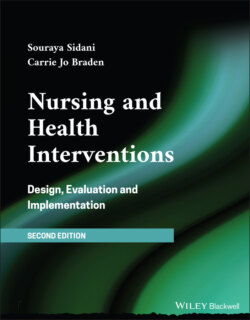Читать книгу Nursing and Health Interventions - Souraya Sidani - Страница 61
3.3.1.2 Methods
ОглавлениеTo be useful in understanding the health problem, middle range theories need to be relevant to the problem of interest. This necessitates a clarification of the problem, identification of available theories, and critical analysis of the theories' description of the problem and propositions regarding its determinants.
Step 1 – Clarification of the Problem
Clarification of the health problem entails an initial delineation of its nature. This is done by addressing the questions: What is the problem exactly about? Is it an actual or potential problem? How is the problem manifested? In what domain of health is it experienced, in what way, by whom, in what context, at what time? Is the concern about the occurrence or the maintenance of the problem? Answers to these questions generate a clear definition of the problem and specification of its attributes, experienced by a particular client population, in a particular context. For example health behaviors are described relative to target, action, context, time, and actors (Aráujo‐Soares et al., 2018). The clarification of the problem guides the search for relevant theories; it provides key terms and sets limits (e.g. client population, context) for conducting the search.
Step 2 – Identification of Theories
Two general methods can be used to identify relevant theories that explain the health problem as defined in Step 1. The first method relies on consultation with scholars and/or health professionals who have expert theoretical and/or clinical knowledge of the health problem. They may have developed, adapted, or been aware of relevant theories. The second method consists of a literature search. The search covers a wide range of sources including: theoretical or conceptual papers that focus on the presentation of the theory or its adaptation to a particular client population or context; textbooks or chapters that describe the health problem from a theoretical or clinical perspective; and grey literature such as professional organizations' websites providing access to white papers or conference presentations about the problem and relevant theories. The search may be extended to empirical papers reporting on studies that tested the theories in different client populations and contexts. Literature sources are selected if they offer a clear description of the theory, which contains a definition of the health problem, identification of its determinants, and propositions explaining the relationships (direct and indirect) between the determinants and the problem.
Step 3 – Analysis of Theories
The analysis of theories consists of the following:
1 The analysis begins by extracting from the selected sources, information on the following elements of each theory identified as relevant to the health problem: name of the theory; conceptual definition of the problem; operational definition of the problem; and possible variations in its indicators across client populations, subgroups comprising a population, and contexts; specification of determinants at different levels; definition of each determinant; delineation of the relationships (direct, indirect) among determinants and the health problem; conceptual explanation of the proposed relationships; and if available, empirical evidence supporting the proposed relationships.
2 The information pertaining to each theory is synthesized across all sources in order to generate a full and accurate description of the theory and its elements. The description is entered into a matrix illustrated in Table 3.2, in preparation for the analysis.
3 The analysis is done for each theory to determine its logical coherence (i.e. consistency between conceptual and operational definitions, logical explanation of the proposed relationships), usefulness in generating a comprehensive and in‐depth understanding of the health problem (e.g. comprehensive list of determinants at different levels), and applicability to the context of the target client population (Mayne, 2017; The Improved Clinical Effectiveness through Behavioral Research Group, 2006).TABLE 3.2 Matrix for analysis of theories.Element of theoryTheory 1Theory 2NameConceptual definition of health problemOperational definition of health problemDefining indicatorsVariations in indicatorsDeterminantsList of determinants at each levelDefinition of determinantsDirect determinantsIndirect determinants:MediatorsModeratorsConceptual explanation ofDirect relationshipsMediated relationshipsModerated relationshipsEmpirically supported relationships
4 The analysis is also done across theories. This analysis consists of comparing and contrasting, qualitatively, the different elements of the theories, as well as their logical coherence, usefulness, and applicability. The results indicate whether (1) a particular theory is most appropriate, logical and consistent with the initial clarification of the problem experienced by the client population within the context of interest; this theory is selected as the theory of the health problem; (2) elements of different theories are complementary or provide supplementary information about the problem and its determinants; these elements are integrated into the theory of the health problem to present a complete and clear understanding of the problem and its determinants; or (3) a theory or integrated elements is(are) useful in understanding the problem but its(their) applicability to the target client population and context cannot be confirmed; in this case, other approaches (e.g. empirical, experiential) could be used to generate the theory of the problem.
The information gained from this analysis assists in formulating the theory or logic model of the health problem. Specifically, the initial definition of the problem is refined as needed. A comprehensive list of determinants is generated and their direct and indirect relationships with the problem are delineated and explained, and where available, supported by empirical evidence.
